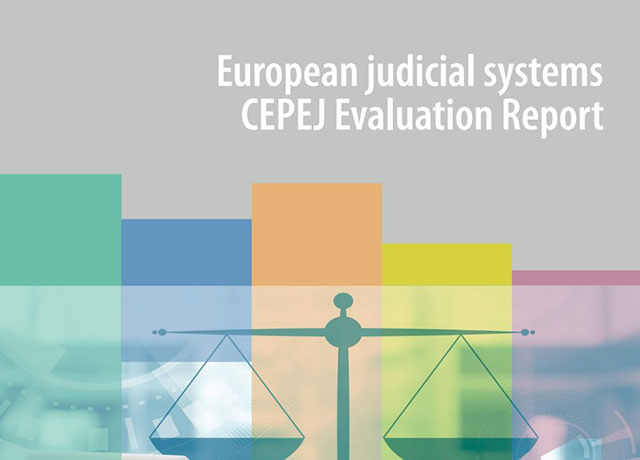Efficiency and quality of justice in Europe: Council of Europe publishes its 2022 report
On Wednesday, 5 October, the Council of Europe’s Commission for the Efficiency of Justice will publish a new report comparing the situation in the judicial sector in 44 member States of the Council of Europe, including Armenia. The report is based on 2020 data.
The report provides an overview of the state of play in the judicial systems in Europe, as well as country profiles with the following data:
Read also
budgets spent on the courts, prosecution services and legal aid,
efficiency of courts (their capacity to cope with the inflow of cases and the estimated number of days needed to resolve a case),
number of courts per capita,
number of judges/prosecutors/lawyers per capita,
salaries of judges and prosecutors in the beginning and the end of career,
gender balance in the judicial sector
ICT usage in the judicial sector.
Presentation of the Report (2020 data)
The European Commission for the Efficiency of Justice was set up by the Committee of Ministers of the Council of Europe in September 2002 and is today a unique body composed of qualified experts from the 46 member States of the Council of Europe. It develops tools and proposes concrete measures to improve the efficiency and quality of the public service of justice for the benefit of its users by ensuring that public policies concerning courts take into account the needs of the justice system users and by offering states effective solutions prior to the points at which an application would be submitted to the European Court of Human Rights and preventing violations of Article 6 of the European Convention on Human Rights, thereby contributing to reducing congestion in the Court.
In order to fulfil these tasks, the CEPEJ has undertaken since 2004 a regular process for evaluating every two years the judicial systems of the Council of Europe member States and certain observer States.
The CEPEJ 2022 Evaluation Report on “European Judicial Systems” is based on 2020 data. 44 member States of the Council of Europe as well as three observer States to the CEPEJ, Israel, Morocco and Kazakhstan, participated in this ninth biennial evaluation cycle.
This edition remains faithful to the evaluation process developed by the CEPEJ and to the methodology of data collection and quality control.
As in the previous cycle, the Report is composed of three different and complementary parts but for the first time it also provides a synthetic analysis of the most notable elements of each country’s judicial system (see “2nd Part Country Profiles”). The content of each part is set out below:
– A first part “tables, graphs, analyses” presents European trends on themes that are important for the judicial systems: budgets, professionals, court organisation, users, IT, efficiency and quality.
o This part presents both an overview of the state of play of judicial systems and the identification of trends in Europe. In order to allow a more interactive reading, each chapter is built around questions which the analyses presented attempt to answer. The general European trend is identified and the specific cases that deviate from it are highlighted.
o In order to address events that had significant impact in 2020, the Report analyses ways in which the COVID-19 crisis affected different aspects of functioning of judicial systems.
- This first part also highlights some of the good practices developed in the member States so that the Report can also serve as a vehicle for exchanges between member States on the functioning of judicial systems.
– A 2nd part “Country profiles” contains the main data and indicators developed by the CEPEJ presented in a synthetic way for each country.
o In this part, CEPEJ responds to a strong expectation of countries in terms of judicial statistics. These country profiles make it possible to situate a state within European context by comparing its key data with the European medians.
o For the first time, the country profile contains also a synthetic analysis of the most notable elements of each judicial system, namely, resources (human, financial), salaries of judges and public prosecutors, gender balance within judicial professions, efficiency of the different courts (civil, criminal, administrative) at all instances (1st, 2nd, Supreme court) through performance indicators developed by the CEPEJ – the Clearance Rate (CR) (court’s capacity to cope with the in-flow of cases) and the Disposition Time (DT) (estimated number of days needed to resolve a case). The activity of public prosecution services is also measured.
o An indicator of the ICT development in each judicial system is also presented in the form of ICT index. This index measures the rate of deployment in different areas of law (civil, administrative, criminal).
– – A 3rd part “CEPEJ-STAT”, the dynamic database of the CEPEJ which contains all the qualitative and quantitative data collected by the CEPEJ since 2010 as well as the comments accompanying each data.
o The database will be enriched with all the 2020 data collected through the CEPEJ evaluation questionnaire, the data presented in part 1 and the other data.
o It also contains various dashboards (synthesis of data, efficiency, budget of judicial systems, new technologies, gender in courts). For this cycle, the CEPEJ has developed a new dashboard on judges and prosecutors.
Main trends
Budget
- European countries spent on average almost 1,1 billion Euros on their judicial systems, equal to 79 € per inhabitant (7 € more than in 2018) and 0,35% of GDP. On average, 66% of this budget are allocated to courts, 24,5% to prosecution authorities and 9,5% to legal aid. Switzerland and Monaco are the countries that spend the most significant amount per inhabitant (217 € and 199 €), in contrast with Georgia (8,7 €) and Azerbaijan (9,6 €), while Montenegro and Bosnia and Herzegovina dedicate to the judicial system the highest percentage of their GDP (0,80% and 0,73%), in contrast with Norway (0,17%), Denmark and Luxembourg (0,17%).
- In 2020, large majority of states and entities have increased the budget allocated to their judicial systems (+8% on average). The most significant percentage increase, equal to 12% on average, has been recorded for the public prosecution budget.
Professionals
- the number of professional judges has slightly increased with the average of 22,2 judges per 100 000 inhabitants; the number of prosecutors also has a generally up-ward trend since 2010, although it is slightly reduced compared to 2018, on average 11,8 prosecutors (from 3 in France, Ireland and Morocco to a maximum of 24 in Latvia and the Republic of Moldova, and 30 in Kazakhstan); the number of lawyers is still increasing in Europe, with an average of 172 lawyers per 100,000 inhabitants (from 20 in Azerbaijan to 485 in Luxembourg);
- complete independence of prosecutors from influence in the prosecution of individual cases is only guaranteed in the minority of states and entities; instructions in individual cases remain possible in many countries;
- the average number of first instance criminal cases per 100 inhabitants received by public prosecutors has significantly decreased since 2010 (from 4,2 to 3,1 cases);
- the average ratio of non-judge staff to professional judges is stable and about 3,9 in 2020 with the minimum of 1,0 in Luxembourg and the maximum of 9,4 in Malta and UK – Northern Ireland;
- 15 European states have set up Rechtspfleger (or similar bodies) in their judicial systems;
- in 2020, the ratio of non-prosecutor staff to prosecutors remained stable and is 1,4 on average;
- for several years now, there have been more female than male judges and prosecutors but the glass ceiling, i.e. an underrepresentation of women in the highest functions, is still present; in 2020, at the level of all instances, there are 56% women judges but only 38% female court presidents; for the prosecutors: 53% women prosecutors but only 38% of female head of public prosecution offices;
- the proportion of women among judges and prosecutors is significantly higher on average in countries where part-time work is possible (59% for judges and 58% for prosecutors) than in countries where it is not (52% for judges and 47% for prosecutors);
- the ratio between salaries of judges and average national salaries shows significant disparities in Europe: from 0/1.7 in Germany (at the beginning/the end of the career) to 6.8/21.6 in Ukraine (at the beginning/the end of the career); the lowest annual salary in absolute amount is in Georgia at the beginning of judges’ career (11,928€) and Republic of Moldova at the end of career (18,631€), while the highest absolute amount of annual salaries is recorder in UK-Scotland at the beginning of career (159,101€) and Switzerland at the end (330,869€);
- the ratio between salaries of prosecutors and average national salaries shows also significant disparities in Europe: it ranges from 0,8 in Ireland to 4,1 in Albania at the beginning of the career, while at the end of career it ranges from 1,7 in Germany and Luxembourg to 7,8 in Georgia; the lowest annual salary in absolute amount is in Azerbaijan at the beginning of prosecutors’ career (6,893€) and Republic of Moldova at the end of career (16,489€), while the highest absolute amount of annual salaries is recorder in Switzerland at the beginning of career (128,770€) and Italy at the end (187,296€);
Courts
- the period 2010 – 2020 is marked by two main trends in terms of court organisation: the number of courts is decreasing in Europe, while their specialisation continues even if it has been slowed down in 2020;
Court users
- the COVID-19 pandemic reinforced the central place of the users in the justice system and accelerated the digitalisation of justice;
- online availability is becoming the dominant way of sharing information with users: 43 states has established websites making available national legislation and court case-law and practical information for court users as well as information about the judicial system;
Information and communication technology (ICT)
- CoE member States and entities are increasingly deploying ICT to support judicial activity, but there are still great differences among states: the general ICT index (court and case management, decision support and communication with courts) vary from 1.6 in UK-Scotland to 9.8 in Estonia and Latvia;
- greater percentage of courts’ budget is being allocated to ICT compared to previous years (+22% more investments in computerisation);
Efficiency
- Because of COVID-19 restrictions, courts throughout Europe encountered problems in executing even daily operations; however, not all jurisdictions were impacted in the same manner as states and entities resorted to various innovative measures to mitigate the COVID-19 effects; first instance courts were impacted the most by the pandemic; the second and third instances were more efficient although achieved somewhat lower results in comparison with 2018;
- The median Clearance Rate of European courts in 2020 remains stable and close to 100%; however, it is worth noting that first instance courts did not reach 100% in any of the three examined case categories (civil and commercial litigious: 98%; administrative: 97%; criminal: 95%);
- Criminal justice is most efficient at all three levels of court (Disposition Time at first instance: 149 days; second instance: 121 days; third instance: 120 days); the third instance courts appear as the most efficient in all matters (Disposition Time in civil and commercial litigious cases: 172 days; administrative cases: 249 days; criminal cases: 120 days) although second instance courts have very similar results;
- in the majority of the states and entities, prosecutors improved the results presumably due to the decrease in the number of new cases caused mainly by the COVID-19 pandemic measures (the European median of cases processed against cases received is 97% compared to 85% in 2018);
- in 2020, the number of incoming cases related to the asylum seekers and the right of entry and stay for aliens decreased, although it remains high. The median Clearance Rates in matters relating to asylum seekers and the right of entry and stay for aliens amount to 98% and 99%, while the Disposition Times comprise 182 and 190 days respectively. The states that are most affected by these case types in 2020 remained Belgium, France, Germany, Italy, Spain, and Sweden, though compared to 2018, the incoming cases declined in all of them, except for Belgium.
























































